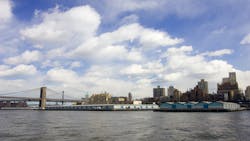New York Commission Authorizes 100-MW Battery Storage Facility
The New York State Public Service Commission (PSC) has confirmed granting the construction and operation of a battery-based energy storage facility with a capacity of up to 100 MW located in Astoria, Queens. The US$132 million facility will be built by East River ESS, LLC. The facility will be developed and operated on a merchant basis and will participate in wholesale energy markets. The facility is expected to be operational by Dec. 31, 2022.
"Energy storage is vital to building flexibility into the grid and advancing Governor Cuomo's ambitious clean energy goals," said Commission Chair John B. Howard. "Projects like East River will enable us to grow the industry and create jobs while we continue on our path toward meeting the largest energy storage target in the nation. When complete, this facility will help to displace energy produced from fossil plants during peak periods, resulting in cleaner air and reduced carbon emissions."
Utility-scale battery storage will play a vital role in New York's clean energy future, especially in New York City where it will help to maximize the benefit of the wind power being developed offshore. The project will help displace fossil fuel-fired generation when the demand for power is highest.
The 100-MW East River Energy Storage System will hold enough electricity to power more than 16,000 average-sized homes for several hours, or enough to power the World Trade Center for about a day. East River ESS, LLC, an affiliate of 174 Power Global that specializes in renewable energy projects, will build and own the battery system off 20th Avenue near the East River on land owned by the New York Power Authority, where the Charles Poletti power plant was formerly located. The battery system will be enclosed in multiple containers totaling approximately 130,680 sq ft. Nearly 70 construction-related jobs will be created during the peak of the nine-month construction period.
The company has a seven-year contract under which Con Edison will have dispatch rights to bid the output from the battery system into the state's wholesale markets. The batteries will be charged from the grid at times when the demand for power is low and less expensive. They will be discharged at times when the demand for power is high, decreasing the need for power from fossil fuel-fired plants. Con Edison and its customers will get the benefit of the revenues from the sales into the wholesale markets during the contract term. At the end of the contract, East River will control the operation and dispatch of the project.
East River is responsible for obtaining the permits to build and operate the project by the end of 2022. The batteries will be in dozens of containers and connected to a nearby Con Edison transmission substation. The batteries will produce no emissions and little noise. As New York’s grid becomes smarter and more decentralized, storage will be deployed to store and dispatch energy when and where it is most needed. Storage will also allow New York to meet its peak power needs without relying on its oldest and dirtiest peak generating plants, many of which are approaching the end of their useful lives.
East River won the project by responding to a request for proposals that Con Edison issued in July 2019. Con Edison has already begun taking advantage of storage technology through several initiatives. The company has a 2-MW battery system in Ozone Park, Queens, to support reliability at times of high demand.
New York is on a path to achieve its mandated goal of a zero-emission electricity sector by 2040, including 70% renewable energy generation by 2030, and to reach economy-wide carbon neutrality.
The project builds on New York's investments to ramp up clean energy including more than US$21 billion in 91 large-scale renewable projects across the state, US$6.8 billion to reduce buildings emissions, US$1.8 billion to scale up solar, more than US$1 billion for clean transportation initiatives, and more than US$1.2 billion in NY Green Bank commitments. Combined, these investments are supporting more than 150,000 jobs in New York's clean energy sector in 2019, a 2100% growth in the distributed solar sector since 2011 and a commitment to develop 9000 MW of offshore wind by 2035.
New York will build on this progress and reduce greenhouse gas emissions by 85% from 1990 levels by 2050, while ensuring that at least 35% with a goal of 40% of the benefits of clean energy investments are directed to disadvantaged communities, and advance progress toward the state's 2025 energy efficiency target of reducing on-site energy consumption by 185 trillion BTUs of end-use energy savings.
The recent decision may be obtained by going to the Commission Documents section of the Commission's website and entering Case Number 21-E-0122 in the input box labeled Search for Case/Matter Number.
